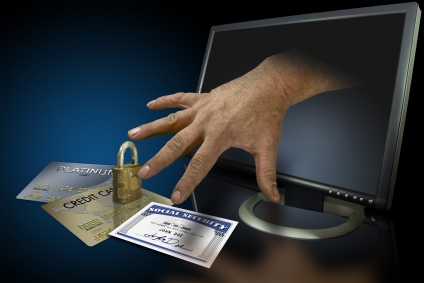Archive for September, 2009
Sunday, September 27th, 2009
 When computer hacker Albert Gonzales pled guilty to charges of conspiracy, access device fraud, wire fraud, and aggravated identity theft, he admitted to accessing information on servers owned by retail chains across the country. When computer hacker Albert Gonzales pled guilty to charges of conspiracy, access device fraud, wire fraud, and aggravated identity theft, he admitted to accessing information on servers owned by retail chains across the country.
As part of a ring of computer data thieves, he helped find weak spots in wireless computer systems, and subsequently installed hidden computer software that enabled him and his cohorts to steal the data from magnetic strips on the backs of credit cards. This information was then sold to other criminals.
Gonzales was involved in yet another crime – because the funds he and his co-criminals were paid was laundered through international accounts.
At this point, no one really knows how many accounts were accessed or the financial magnitude of the theft. Some believe that the assets seized will not cover the losses.
Interestingly, part of Gonzales’s crime is that of acting in the role of a “double agent.” When he was arrested in 2003 he got special treatment by promising to cooperate with and assist authorities as they closed in on his associates. Instead, he used the information given him by the Secret Service to warn those associates that they were in danger of apprehension.
He is now plea-bargaining for a reduced sentence in exchange for information about his crimes.
Experts advise consumers to avoid using credit cards with retailers who don’t have a strong security system. But how is the average consumer to know if their favorite retailer has a hacker-proof system? And, is there even such a thing as a hacker-proof system?
The crooks who seek to steal information are every bit as intelligent and experienced as the technicians who seek to stop them. In addition, it is entirely possible that the very crooks they seek to thwart are on the teams of computer experts hired to prevent access. After all, they are among the brightest technicians in the world.
What can consumers do to protect themselves?
Locking the report will prevent new accounts from being opened under their names, and that’s a good start. Discontinuing all use of credit cards will prevent theft such as Gonzales committed, but will not prevent access to information that is already stored in government and business data bases. All of us have information that is out there and accessible under the right circumstances.
The only real security for consumers is to keep a constant watch on their credit reports, so that any unauthorized activity can be halted immediately. The smartest move is to enroll in credit monitoring, which will immediately alert the consumer to any changes that might signal identity theft.
Author: Mike Clover
CreditScoreQuick.com your resource for free credit reports, credit cards, loans, and ground breaking credit news.
Posted in Uncategorized | Comments Off
Saturday, September 26th, 2009
 You want to get a mortgage loan – either to refinance, or to sell your home – but what is it really worth in today’s market? You want to get a mortgage loan – either to refinance, or to sell your home – but what is it really worth in today’s market?
Many consumers begin with using an on-line appraisal from sites such as Zillow.com, Trulia.com, or even a lender’s website. But how accurate are those appraisals? Often the answer is “not very.” In fact, some are as much as 25% “off.”
Two major problems can render these appraisals useless. The first is timeliness. Most sites uses comparables from the past 6 months. While once that was a reasonable length of time, today it is not. Values can change in as little as two weeks.
Next is the human element. A website cannot see the condition of your home, nor of the homes used for comparison. It also cannot view the neighborhood and determine if it is in a stable, improving, or declining area. Thus, the only true appraisal must come from a certified appraiser who knows the local market and is skilled in factoring in all the variables. And there comes the next hurdle.
Under the new HVCC rules, your home could be appraised by someone completely unfamiliar with your neighborhood and your local market.
Because finger-pointers needed someone to blame for the housing crisis, appraisers came under the gun. Some believed that appraisers who were too well acquainted with real estate agents and/or mortgage lenders were bringing in over-valued appraisals in order to make transactions close. So a new rule was born.
Under HVCC, the Home Valuation Code of Conduct, real estate agents and mortgage brokers are no longer allowed to choose appraisers known to be familiar with the neighborhoods in question. In fact, they are not allowed to have any contact with the appraiser, for fear that they might influence his or her valuation.
Now, when a mortgage lender orders an appraisal, the request goes to a third-party Appraisal Management Company. That company then orders an appraisal from the next name on the list – without regard to the appraiser’s knowledge of the community in question. Often, the assigned appraiser lives as much as 100 miles from the subject property and has never seen any of the properties that might be used as comparables.
In addition, since the Appraisal Management Company takes as much as 33% of the fee paid by the consumer, those appraisers are paid less and are in a hurry to get the job done.
The HVCC is not a benefit to anyone except the Appraisal Management Companies. Thankfully, legislation has been introduced into the House of Representatives that would force an 18 month moratorium on HVCC. It will be in the best interests of homeowners, home buyers, home sellers, and appraisers if that legislation passes.
Author: Mike Clover
CreditScoreQuick.com your resource for free credit reports, credit cards, loans, and ground breaking credit news.
Posted in Uncategorized | Comments Off
Friday, September 18th, 2009
 At first glance a spend to save credit card sounds like a fine idea – enforced savings for those who are lax about putting a little aside each month. At first glance a spend to save credit card sounds like a fine idea – enforced savings for those who are lax about putting a little aside each month.
The promise that the bank will match up to 5% of your savings seems like an even better incentive to use these cards, but a closer look shows that this type of credit card may cost more than it saves.
When using these cards, such as Bank of America’s Keep the Change and Wachovia’s Way2Save, every time you use your credit or debit card the purchase is rounded up to the next dollar, with “the change” going into your savings account. If you use your card often, you could save a few dollars every day and, as the ads tout, not even notice it.
But if you’re carrying a balance on that credit card, your savings will simply cost too much. You’d be better off putting change in a jar.
These savings accounts typically pay under 1% interest per anum – while your credit card interest is probably 12% or more. So for a $100 savings account you’ll gain perhaps one dollar, while paying $12 to carry that additional balance on your credit card account.
If you pay your balance in full each month, or if the money is coming out of your checking account via a debit card, you might come out ahead. But that’s not even guaranteed. Many of these spend-to-save credit cards impose a monthly fee for the service. It may be waived if you maintain a pre-set balance or if you set up an automatic transfer from checking to savings each month. Some programs require you to make a check card or online bill pay purchase monthly to avoid the charge.
Thus, the charges associated with these accounts can quickly wipe out both the money you’ve saved and interest it might earn. If you’re thinking of a spend-to-save credit card, be sure to read all the fine print before you apply.
Consumers who are seriously interested in savings should take an active role, rather than try to trick themselves into “painless” savings.
Set up a savings account at the bank where you have your checking account. Then set up on-line banking that allows you to transfer money between your accounts. Make a commitment to yourself to transfer a few dollars to savings each time you make a deposit to checking.
Author: Mike Clover
CreditScoreQuick.com your resource for free credit reports, credit cards, loans, and ground breaking credit news.
Posted in Uncategorized | 1 Comment »
Thursday, September 17th, 2009
The CARD Act, signed into law last May and taking effect in February, brings welcome changes to credit card practices, but doesn’t cover everything.
One of the most welcome changes is an end to retroactive rate increases. Unless you’re 60 days late with payment, or have chosen a variable rate card, your credit card company won’t be allowed to change the interest rate on balances you already owe.
This is welcome news to card holders who saw interest rates jump from under 10% to nearly 30% over the past few months. However, it doesn’t affect changes already made.
What it doesn’t change is the bank’s right to change interest rates on your future purchases. They do have to notify you 45 days in advance of the change, so you do still need to read all your mail and take heed.
In addition, credit card issuers will still be allowed to set any interest rate they want, and completely ignore State usury laws. Through a series of actions by Congress over past years, banks were given loopholes that made them exempt.
One relief offered in the CARD Act is fairer payment allocation. So if you do forget to check and do make a purchase under a new, high interest rate, you will now have the opportunity to pay off that balance rather than having it “buried” behind any low interest balance you may have.
There is a catch, however. Your minimum payment will go first to the month’s interest, then to your low interest balance. It is only the amount you pay above the minimum that will apply to your high interest balance. In other words, if you want to pay it off, you need to increase your monthly payment.
Another practice that was not eliminated is the arbitrary reduction in your credit limit. Card issuers will still be allowed to do this – and with no notice to you. The only relief offered in the CARD Act is that they will no longer be allowed to drop your limit below your outstanding balance, triggering an over limit fee.
Card holders who wish to avoid over limit fees can opt not to have them – by telling their card issuers to refuse any charges that would take them over the limit. If card users do elect to allow over limit fees, they cannot be charged for more than one per cycle.
Author: Mike Clover
CreditScoreQuick.com your resource for free credit reports, credit cards, loans, and ground breaking credit news.
Posted in Uncategorized | Comments Off
Thursday, September 17th, 2009
 For thousands of citizens, the answer is probably yes. Reading, combined with some math and careful consideration of future possibilities could have prevented both the mortgage crisis and the credit card crisis. For thousands of citizens, the answer is probably yes. Reading, combined with some math and careful consideration of future possibilities could have prevented both the mortgage crisis and the credit card crisis.
Certain mortgage companies and their representatives were notorious for burying complex terms and expensive restrictions well into the fine print. And, since loan documents are both lengthy and ponderous to read, most borrowers did not read them.
Loan closers, anxious to get the signatures and get on to the next closing, did not encourage that reading, but assured buyers that there was “nothing out of the ordinary” in the documents.
Further, buyers who were not confident in their abilities to read and understand the documents went along with it rather than stop the process and demand time to read.
In other cases, buyers raised concerns that were brushed aside by mortgage lenders. Phrases like “You can refinance before the rate increases,” and “Inflation will let you refinance in a couple of years without mortgage insurance” lured many into seeing the rosy glow of the future rather than the reality of what they were signing.
And in some cases, they really didn’t know what they were signing. I remember one seller who had no idea that his loan carried a pre-payment penalty until he was ready to close and realized he had to contribute money. What a shock!
Credit card agreements were just as bad, or possibly worse. Their fine print was written in type so small that many card holders needed a magnifying glass just to read it.
New federal regulations are doing away with some of the problem. Credit card issuers will now be required to disclose fees, interest rates, and other terms in print large enough and prominent enough for consumers to find and read.
Home buyers are also getting some protection, but will still need to use common sense to determine whether they should sign loan documents.
The new regulations from Fannie Mae require that borrowers be given an accurate Truth in Lending statement at least 3 days before closing. The Truth in Lending statement discloses the annual percentage rate, finance charges, amount financed, total payments, payment schedule and other loan terms. Hopefully, this will include the existence of pre-payment penalties, and the existence or non-existence of caps on variable rate interest.
Proposed future reforms include the requirement that lenders give borrowers a one-page outline of all their loan terms – including the risky ones.
CreditScoreQuick.com
Posted in Uncategorized | Comments Off
Wednesday, September 16th, 2009
 Self-employed individuals are finding it more and more difficult to obtain mortgage loans in today’s economic climate. High credit scores are no longer enough to guarantee success. Self-employed individuals are finding it more and more difficult to obtain mortgage loans in today’s economic climate. High credit scores are no longer enough to guarantee success.
As lenders require more and more verification of income, those without an employer and a W-2 form to present must show proof in other ways. Under new regulations, mortgage brokers are required to verify existence of the business by contacting an independent third party, such as a tax accountant, a regulatory agency, or the applicable licensing bureau. Their records must include how they gained contact information, the name of the person they spoke with, and their position.
Next, they must verify a telephone listing and address for the business by consulting telephone books, directory assistance, and/or the Internet. This research must also be documented in their loan files. This could present a problem for individuals who operate a business from their own homes, and those whose entire business is conducted over the internet or “on site” without benefit of a storefront.
In addition, mortgage brokers must obtain a copy of every individual’s income tax records and keep that information in the loan file.
Previously, borrowers were required to sign an IRS form giving the mortgage lender permission to obtain IRS records, and the lender could decide if or when to submit the form to obtain tax information.
Under new Fannie Mae guidelines effective September 1, the lender is required to obtain a signed Form 4606-T from all borrowers both at application and at closing. They then “recommend” that lenders obtain the tax transcripts prior to closing and use them to validate the income documentation used during the underwriting process.
This is the biggest hurdle for the self employed. After spending years carefully studying tax regulations and learning of every possible tax deduction, many very successful self-employed individuals appear to have hardly any income.
In the past, mortgage lenders were able to overlook certain expenses such as deductions for a home office and certain depreciation and add them back into the borrower’s income. This may no longer be the case, so self-employed individuals are being encouraged to be less aggressive in finding deductions.
Along with setting up a roadblock for the self-employed, this new regulation adds paperwork for the mortgage lender. Files are selected at random for quality control reviews, and those files must include the executing and reconciliation of the transcript information with the income documents in the loan file.
Author:Marte Cliff
CreditScoreQuick.com your resource for free credit reports, credit cards, loans, and ground breaking credit news.
Posted in Uncategorized | 1 Comment »
Wednesday, September 16th, 2009
 If you believe even a small savings is worthwhile, then paying your credit card bills sooner is a money saving tactic you’ll love. If you believe even a small savings is worthwhile, then paying your credit card bills sooner is a money saving tactic you’ll love.
You pay the same amount, but the timing creates a few dollars of savings each month.
When you carry a balance on your credit cards you have no grace period, so you are charged interest every day until the bill is paid in full. Not only that, you’re charged interest on your average daily balance, which includes the interest added each day.
Considering that you probably are earning zero interest on money in your checking account and could be paying up to 29.9% on your credit card balance, it makes sense to make that payment just as soon as possible.
The more you owe on that revolving balance and the higher the interest rate you’re paying, the more you will save by shaving a few day’s interest off each month. If you make your payment on the day after your statement comes out you reduce your average daily balance for the current month by the amount of your payment.
Thus, if your payment includes a principal payment of $100, your average daily balance for next month will be $100 less if you pay it on the first day of the billing cycle than if you paid it on the last day.
At an interest rate of 18%, you’d save $1.50 by making that payment early. Not a lot, but when you’re trying to get out of debt, every small savings does add up.
You can also save on interest by making small payments in addition to your monthly payment. Even an extra $5 to $10 paid each week can make a big difference in the interest you pay over a year’s time. These small payments are easy to make if you’ve set up online bill pay for each of your credit card accounts.
Of course, if you have a sudden windfall such as a bonus check, putting a chunk of it down on your credit card bill the day it arrives can make a big difference in the interest you’ll pay.
Do remember that you need to wait until the statement is generated to make “regular” payments. A payment made the day before the billing cycle begins will apply to your principal balance, but if you don’t make a payment during the next billing cycle, you’ll still be considered past due.
Author:Marte Cliff
CreditScoreQuick.com your resource for free credit reports, credit cards, loans, and ground breaking credit news.
Posted in Uncategorized | 1 Comment »
Monday, September 14th, 2009
 Last Spring, as Congress and the President considered the rules that would go into the CARD Act, one concern was to prevent banks from targeting young people and enticing them into debt through student credit cards. Last Spring, as Congress and the President considered the rules that would go into the CARD Act, one concern was to prevent banks from targeting young people and enticing them into debt through student credit cards.
Credit card companies often set up on college campuses, offering incentives to college students to “sign up today.” These were everything from teddy bears to backpacks to pizza coupons, and students were eagerly accepting the gifts.
Others, including high school students, received seemingly attractive student credit card offers in the mail.
Sadly, many of those credit card accounts were what are generally known as “fee harvester” cards. When a consumer makes application and is accepted for such a card, he or she is hit with a hefty bill for “fees” before ever using the card. These can include application fees, activation fees, monthly fees, and more.
The students, in their eagerness to own a student credit card, didn’t stop to read the fine print.
In addition, widespread concern over growing debt loads among youth led these lawmakers to restrict credit availability to young people.
When the CARD Act’s provisions go into effect in February, students will be required to have either a job or a co-signer in order to receive a credit card. In addition, the credit limit on such cards will be severely restricted.
Unfortunately, legislation such as this has a dark side for students.
The fact is, upon graduation students who have established credit will have a far easier time entering the workplace, renting a home, and buying a car. Rather than avoid using a credit card during these school years, students should establishing a record of responsible money management through wise student credit card usage – and thus building high credit scores.
The first step is to ignore the solicitations – either in person or by mail – and do the research to find a card with good rates and terms.
Next is to do it now – before February rolls around and the opportunity is lost.
Once you have the card, use it sparingly, but use it. Make it a point never to let your statement show a balance in excess of 30% of your available credit. If you’ve gotten a card with a $200 limit that means you won’t be buying much – but also means you should be able to pay off the balance each time the statement arrives. Use the card at least once every 3 months to avoid having it closed for inactivity.
Author:Marte Cliff
CreditScoreQuick.com your resource for free credit reports, credit cards, loans, and ground breaking credit news.
Posted in Uncategorized | Comments Off
Monday, September 14th, 2009
 New mortgage lending rules designed to give consumers better information and thus make better loan choices may not be as beneficial as some believe. New mortgage lending rules designed to give consumers better information and thus make better loan choices may not be as beneficial as some believe.
Under the new rule, a lender may not charge a borrower any fees beyond the credit report fee until that borrower has been given a Truth in Lending Statement. This statement, commonly known as the TIL, discloses the annual percentage rate, finance charges, amount financed, total payments, along with a payment schedule and loan terms.
By preventing lenders from collecting other fees prior to the Truth in Lending Statement, regulators sought to give buyers more choices and more opportunity to compare lenders and loan programs. They will no longer be locked to a lender by application or appraisal fees already paid.
And lenders will be bound by the TIL. Borrowers will no longer be told their origination fee is 1%, only to learn at closing that they must pay 3%.
Because lenders won’t order the appraisal until the 3 day waiting period has expired and the borrower has paid the appraisal fee, the first delay occurs at the beginning of the loan process. The loan cannot close for 7 days after receipt of the initial TIL, but that part of the rule really has no effect at the beginning of the loan process. Loans are not likely to close within 7 days from application.
The problem comes as the loan progresses, when any change of 0.125% (1/8 %) in the APR will require a new TIL – after which the loan may not close for 3 days. Often a change in interest rate, loan program or loan-related fees will trigger this change at the last minute.
That can spell additional expense for consumers who are up against a deadline for a loan lock, or who are purchasing a short sale with a per diem penalty for delayed closing.
Lenders must now give this TIL to borrowers seeking a refinance as well as those purchasing a home. Thus, a homeowner hoping to expedite a refinance loan in order to avoid foreclosure could find himself beyond the deadline.
Homeowners trying to close a “streamlined” refinance guaranteed by FHA could also face a big expense when their loan cannot close within the last 3 days of the month. If they miss this window, they’ll have to wait another month or pay an extra month’s interest, along with probably missing a rate lock.
Author:Marte Cliff
CreditScoreQuick.com your resource for free credit reports, credit cards, loans, and ground breaking credit news.
Posted in Uncategorized | 1 Comment »
Friday, September 11th, 2009
Q
I recently Declared Bankruptcy which was discharged at the end of August. What items should still be showing on my report. I have one service which is indicating 3 open accounts (correct) but some 30 old closed and charged off accounts including ones that were discharged during the bankruptcy. Should these (old accounts) be cleared from my report? If so how?
David
A:
Hi David,
this is a common question after filing bankruptcy. Here is a article on how long collections and bankruptcies stay on your credit report. Also there is information on how to get the old stuff off. Let us know if you have anymore questions.
Mike Clover
CreditScoreQuick.com
Posted in Uncategorized | Comments Off
Disclaimer: This information has been compiled and provided by CreditScoreQuick.com as an informational service to the public. While our goal is to provide information that will help consumers to manage their credit and debt, this information should not be considered legal advice. Such advice must be specific to the various circumstances of each person's situation, and the general information provided on these pages should not be used as a substitute for the advice of competent legal counsel.

|
 When computer hacker Albert Gonzales pled guilty to charges of conspiracy, access device fraud, wire fraud, and aggravated identity theft, he admitted to accessing information on servers owned by retail chains across the country.
When computer hacker Albert Gonzales pled guilty to charges of conspiracy, access device fraud, wire fraud, and aggravated identity theft, he admitted to accessing information on servers owned by retail chains across the country.


 You want to get a mortgage loan – either to refinance, or to sell your home – but what is it really worth in today’s market?
You want to get a mortgage loan – either to refinance, or to sell your home – but what is it really worth in today’s market? At first glance a spend to save credit card sounds like a fine idea – enforced savings for those who are lax about putting a little aside each month.
At first glance a spend to save credit card sounds like a fine idea – enforced savings for those who are lax about putting a little aside each month. For thousands of citizens, the answer is probably yes. Reading, combined with some math and careful consideration of future possibilities could have prevented both the mortgage crisis and the credit card crisis.
For thousands of citizens, the answer is probably yes. Reading, combined with some math and careful consideration of future possibilities could have prevented both the mortgage crisis and the credit card crisis. Self-employed individuals are finding it more and more difficult to obtain mortgage loans in today’s economic climate. High credit scores are no longer enough to guarantee success.
Self-employed individuals are finding it more and more difficult to obtain mortgage loans in today’s economic climate. High credit scores are no longer enough to guarantee success. If you believe even a small savings is worthwhile, then paying your credit card bills sooner is a money saving tactic you’ll love.
If you believe even a small savings is worthwhile, then paying your credit card bills sooner is a money saving tactic you’ll love. Last Spring, as Congress and the President considered the rules that would go into the CARD Act, one concern was to prevent banks from targeting young people and enticing them into debt through student credit cards.
Last Spring, as Congress and the President considered the rules that would go into the CARD Act, one concern was to prevent banks from targeting young people and enticing them into debt through student credit cards. New mortgage lending rules designed to give consumers better information and thus make better loan choices may not be as beneficial as some believe.
New mortgage lending rules designed to give consumers better information and thus make better loan choices may not be as beneficial as some believe.